TOYOTA TACOMA 2017 Owners Manual (in English)
Manufacturer: TOYOTA, Model Year: 2017, Model line: TACOMA, Model: TOYOTA TACOMA 2017Pages: 640, PDF Size: 11.07 MB
Page 1 of 640
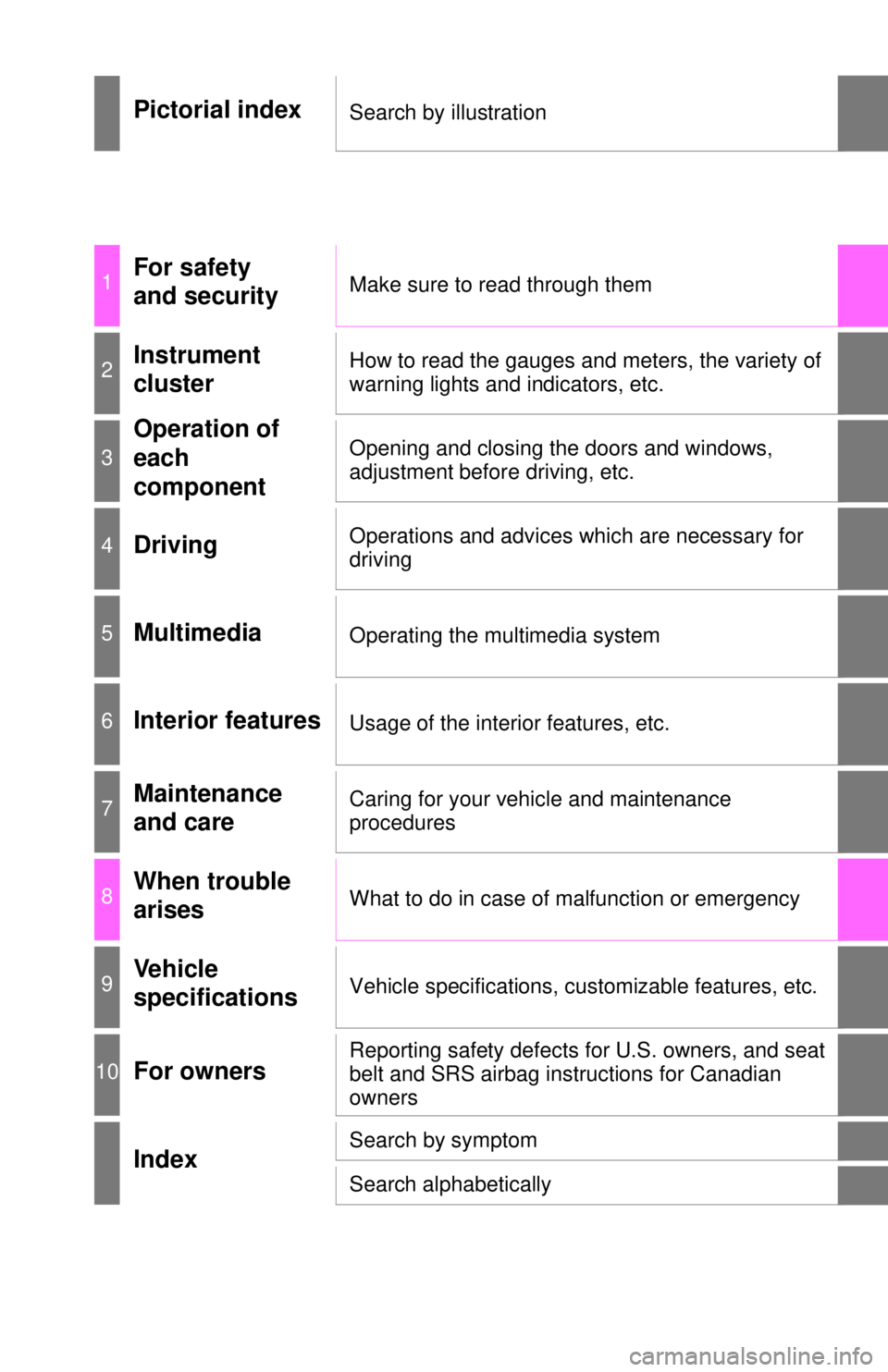
Pictorial indexSearch by illustration
1For safety
and securityMake sure to read through them
2Instrument
clusterHow to read the gauges and meters, the variety of
warning lights and indicators, etc.
3
Operation of
each
componentOpening and closing the doors and windows,
adjustment before driving, etc.
4DrivingOperations and advices which are necessary for
driving
5MultimediaOperating the multimedia system
6Interior featuresUsage of the interior features, etc.
7Maintenance
and careCaring for your vehicle and maintenance
procedures
8When trouble
arisesWhat to do in case of malfunction or emergency
9Vehicle
specificationsVehicle specifications, customizable features, etc.
10For ownersReporting safety defects for U.S. owners, and seat
belt and SRS airbag instructions for Canadian
owners
IndexSearch by symptom
Search alphabetically
Page 2 of 640

TABLE OF CONTENTS2
For your information....................... 8
Reading this manual .................... 12
How to search .............................. 13
Pictorial index .............................. 14
1-1. For safe useBefore driving ...................... 24
For safety drive ................... 26
Seat belts ............................ 28
SRS airbags ........................ 34
Front passenger occupant classification system ......... 45
Safety information for children ........................ 50
Child restraint systems ........ 51
Installing child restraints ...... 55
Exhaust gas precautions ..... 68
1-2. Theft deterrent system Engine immobilizer system............................... 69
Alarm ................................... 78
2. Instrument cluster Warning lights and indicators........................... 82
Gauges and meters............. 88
Multi-information display ..... 93
Fuel consumption information ........................ 98 3-1. Key information
Keys................................... 102
3-2. Opening, closing and locking the doors
Doors ................................. 109
Tailgate .............................. 116
Smart key system .............. 121
3-3. Adjusting the seats Front seats......................... 129
Rear seats ......................... 131
Head restraints .................. 134
3-4. Adjusting the steering wheel and mirrors
Steering wheel ................... 138
Inside rear view mirror ....... 140
Outside rear view mirrors ............................. 143
3-5. Opening, closing the windows and moon roof
Power windows.................. 145
Back window (vehicles with sliding type) .............. 148
Power back window ........... 149
Moon roof .......................... 151
1For safety and security
2Instrument cluster
3Operation of
each component
Page 3 of 640

3
1
9 8
7 5 4
3
2
10
6
4-1. Before drivingDriving the vehicle ............. 156
Cargo and luggage............ 165
Vehicle load limits ............. 169
Trailer towing..................... 170
Dinghy towing.................... 188
4-2. Driving procedures Engine (ignition) switch (vehicles without
a smart key system) ........ 189
Engine (ignition) switch (vehicles with a smart
key system) ..................... 192
Automatic transmission ..... 197
Manual transmission ......... 202
Turn signal lever................ 204
Parking brake .................... 205
4-3. Operating the lights and wipers
Headlight switch ................ 206
Fog light switch ................. 210
Windshield wipers and washer ............................ 211
4-4. Refueling Opening the fuel tank cap .................................. 214 4-5. Using the driving support
systems
Cruise control .................... 218
Intuitive parking assist ....... 223
Rear view monitor system ............................. 229
BSM (Blind Spot Monitor)......... 239
• The Blind Spot Monitor function.......................... 241
• The Rear Cross Traffic Alert function ................. 244
Four-wheel drive system ... 247
AUTO LSD system ............ 251
Rear differential lock system ............................. 253
Active traction control system ............................. 256
Multi-terrain Select............. 258
Crawl Control ..................... 262
Clutch start cancel switch .............................. 266
Driving assist systems ....... 267
4-6. Driving tips Winter driving tips .............. 273
Off-road precautions .......... 277
4Driving
Page 4 of 640

TABLE OF CONTENTS4
5-1. Basic OperationsAudio system types ........... 284
Audio system..................... 286
Steering wheel audio switches .......................... 288
USB Port/AUX Port ........... 289
Basic audio operations ...... 290
5-2. Setup Setup menu ....................... 292
General settings ................ 293
Audio settings.................... 295
Display settings ................. 296
Voice settings .................... 297
5-3. Using the multimedia system Selecting the audio source ............................. 298
List screen operation ......... 299
Optimal use of the multimedia system .......... 301
5-4. Using the radio Radio operation ................. 302
5-5. Playing an audio CD and MP3/WMA/AAC discs
CD player operation .......... 304
5-6. Using an external device Listening to an iPod........... 309
Listening to a USB memory device................ 313
Using the AUX port ........... 317 5-7. Connecting Bluetooth
®
Preparations to use
wireless
communication ................ 318
Registering a Bluetooth
®
audio player
for the first time................ 324
Registering a Bluetooth
®
phone for the first time .... 325
Registering a Bluetooth
®
device .............................. 326
Connecting a Bluetooth
®
device .............................. 328
Displaying a Bluetooth
®
device details................... 330
Detailed Bluetooth
®
system settings................ 331
5-8. Bluetooth
® audio
Listening to Bluetooth®
audio................................ 332
5-9. Bluetooth
® phone
Using a Bluetooth®
phone .............................. 333
Making a call...................... 335
Receiving a call ................. 338
Speaking on the phone...... 339
Bluetooth
® phone
message function ............ 342
Using the steering wheel switches ................ 346
Bluetooth
® phone
settings ............................ 347
Contact/Call History Settings ........................... 349
What to do if... (Troubleshooting) ............ 358
5-10. Bluetooth
®
Bluetooth®......................... 362
5-11. Using the voice command system
Voice command system .... 367
5Multimedia
Page 5 of 640
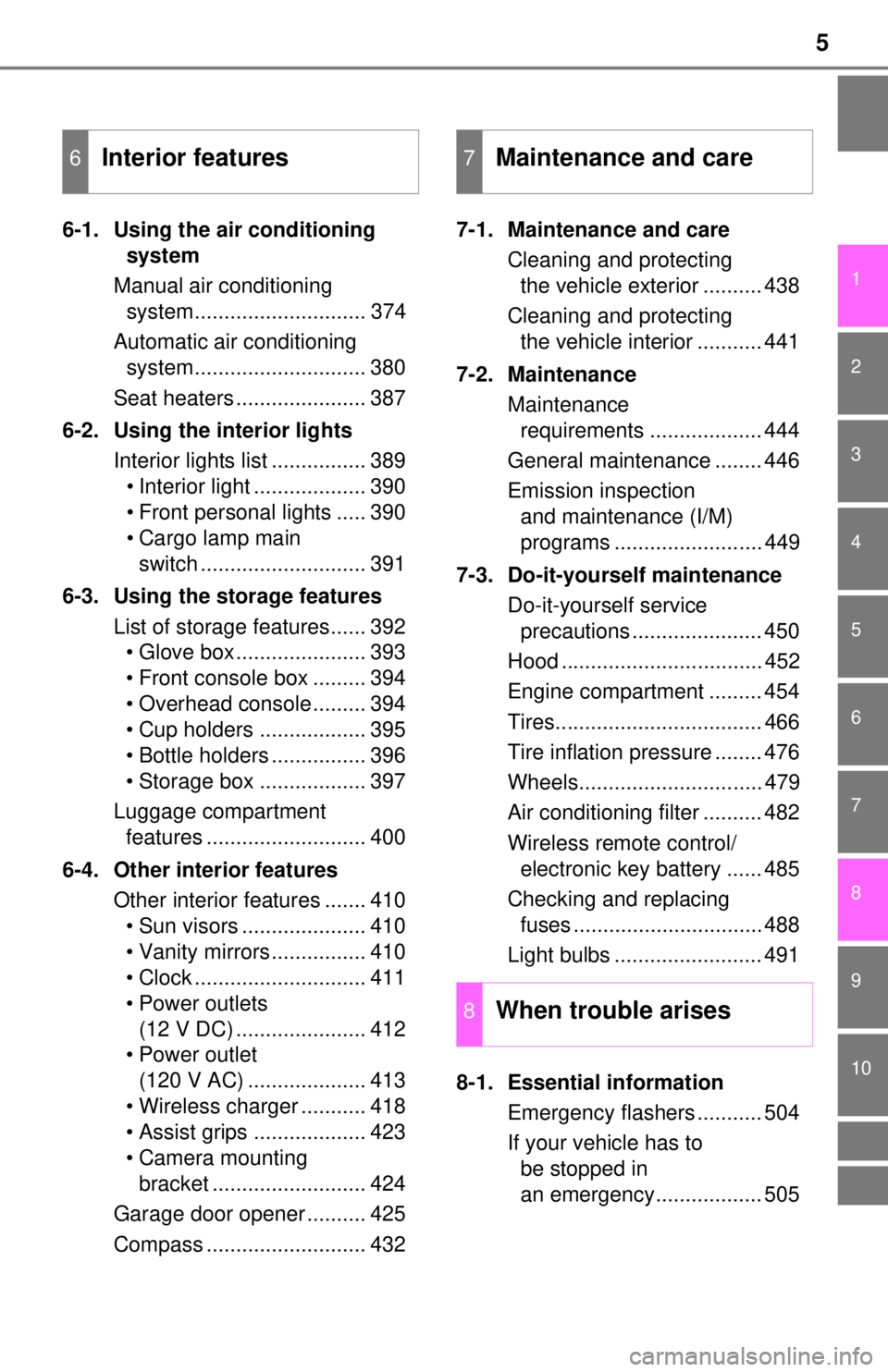
5
1
9 8
7 5 4
3
2
10
6
6-1. Using the air conditioning system
Manual air conditioning system............................. 374
Automatic air conditioning system............................. 380
Seat heaters ...................... 387
6-2. Using the interior lights Interior lights list ................ 389• Interior light ................... 390
• Front personal lights ..... 390
• Cargo lamp main switch ............................ 391
6-3. Using the storage features List of storage features...... 392• Glove box...................... 393
• Front console box ......... 394
• Overhead console ......... 394
• Cup holders .................. 395
• Bottle holders ................ 396
• Storage box .................. 397
Luggage compartment features ........................... 400
6-4. Other interior features Other interior features ....... 410• Sun visors ..................... 410
• Vanity mirrors................ 410
• Clock ............................. 411
• Power outlets (12 V DC) ...................... 412
• Power outlet
(120 V AC) .................... 413
• Wireless charger ........... 418
• Assist grips ................... 423
• Camera mounting bracket .......................... 424
Garage door opener .......... 425
Compass ........................... 432 7-1. Maintenance and care
Cleaning and protecting the vehicle exterior .......... 438
Cleaning and protecting the vehicle interior ........... 441
7-2. Maintenance Maintenance requirements ................... 444
General maintenance ........ 446
Emission inspection and maintenance (I/M)
programs ......................... 449
7-3. Do-it-yourself maintenance Do-it-yourself service precautions ...................... 450
Hood .................................. 452
Engine compartment ......... 454
Tires................................... 466
Tire inflation pressure ........ 476
Wheels............................... 479
Air conditioning filter .......... 482
Wireless remote control/ electronic key battery ...... 485
Checking and replacing fuses ................................ 488
Light bulbs ......................... 491
8-1. Essential information Emergency flashers ........... 504
If your vehicle has to be stopped in
an emergency.................. 505
6Interior features7Maintenance and care
8When trouble arises
Page 6 of 640
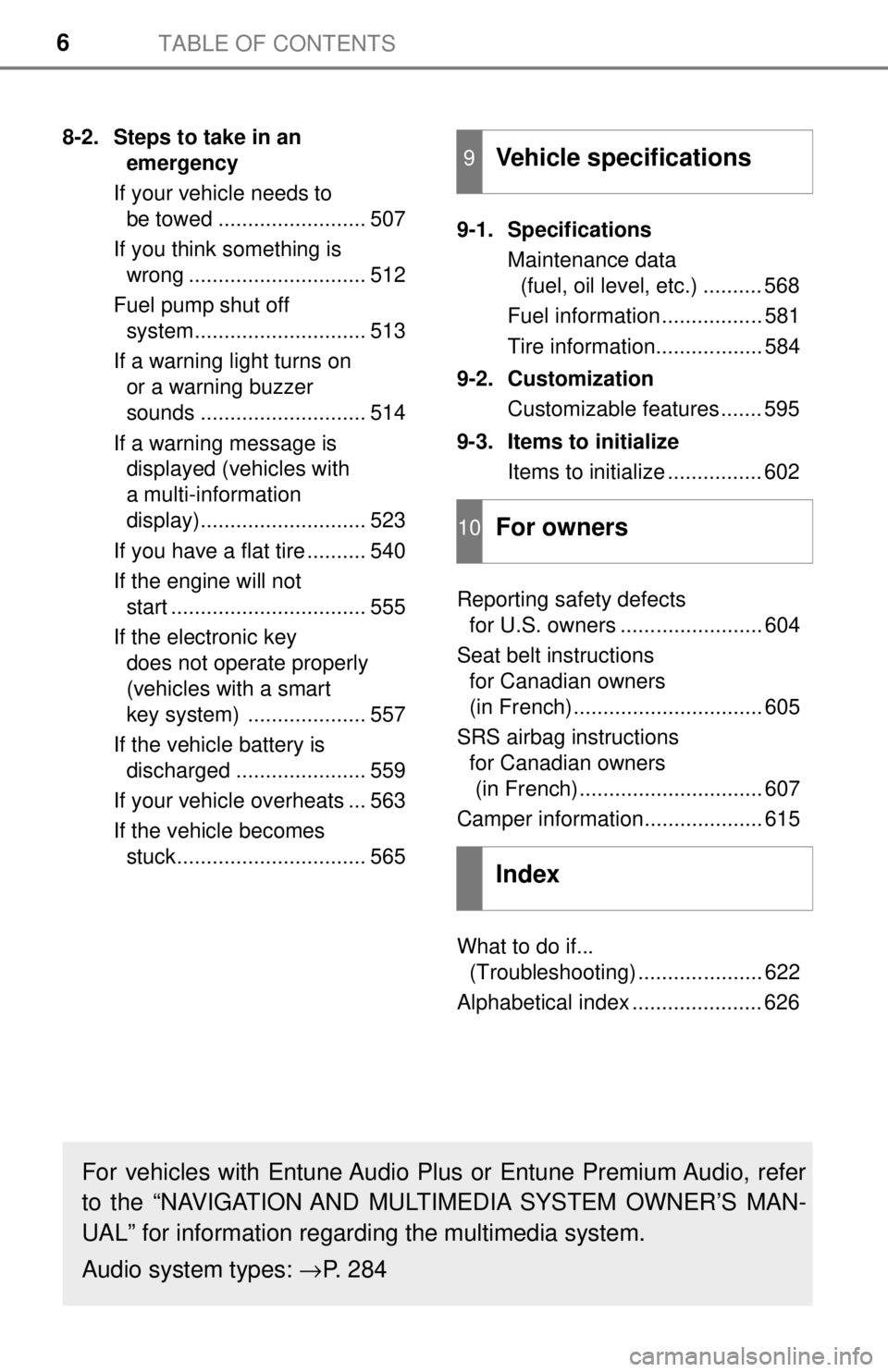
TABLE OF CONTENTS6
8-2. Steps to take in an emergency
If your vehicle needs to be towed ......................... 507
If you think something is wrong .............................. 512
Fuel pump shut off system............................. 513
If a warning light turns on or a warning buzzer
sounds ............................ 514
If a warning message is displayed (vehicles with
a multi-information
display)............................ 523
If you have a flat tire .......... 540
If the engine will not start ................................. 555
If the electronic key does not operate properly
(vehicles with a smart
key system) .................... 557
If the vehicle battery is discharged ...................... 559
If your vehicle overheats ... 563
If the vehicle becomes stuck................................ 565 9-1. Specifications
Maintenance data (fuel, oil level, etc.) .......... 568
Fuel information ................. 581
Tire information.................. 584
9-2. Customization Customizable features ....... 595
9-3. Items to initialize Items to initialize ................ 602
Reporting safety defects for U.S. owners ........................ 604
Seat belt instructions for Canadian owners
(in French)................................ 605
SRS airbag instructions for Canadian owners
(in French)............................... 607
Camper information.................... 615
What to do if... (Troubleshooting) ..................... 622
Alphabetical index ...................... 6269Vehicle specifications
10For owners
Index
For vehicles with Entune Audio Plus or Entune Premium Audio, refer
to the “NAVIGATION AND MULTIMEDIA SYSTEM OWNER’S MAN-
UAL” for information regarding the multimedia system.
Audio system types: →P. 284
Page 7 of 640

7
1
9 8
7 5 4
3
2
10
6
Page 8 of 640
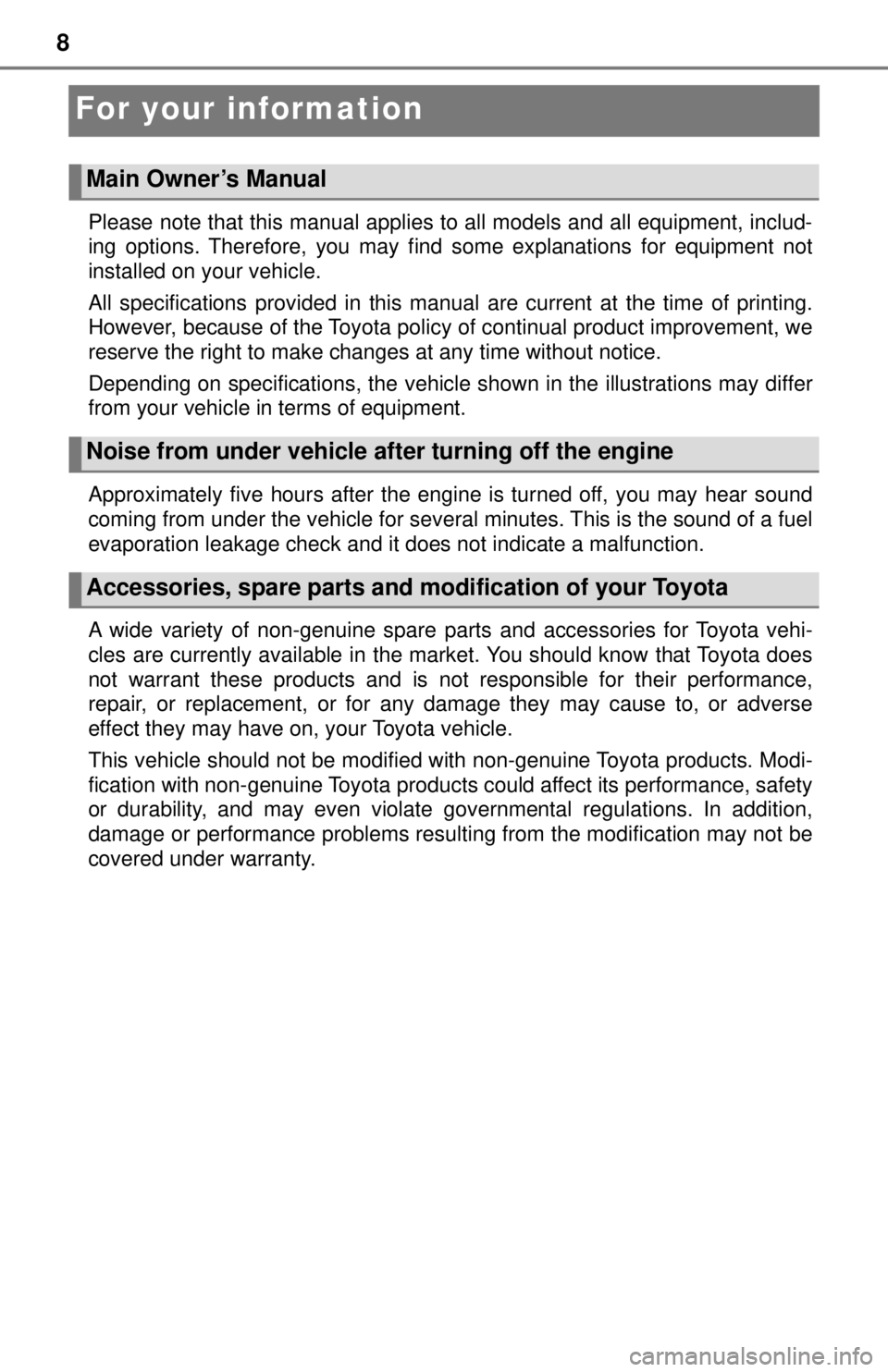
8
For your information
Please note that this manual applies to all models and all equipment, includ-
ing options. Therefore, you may find some explanations for equipment not
installed on your vehicle.
All specifications provided in this manual are current at the time of printing.
However, because of the Toyota policy of continual product improvement, we
reserve the right to make changes at any time without notice.
Depending on specifications, the vehicle shown in the illustrations may differ
from your vehicle in terms of equipment.
Approximately five hours after the engine is turned off, you may hear sound
coming from under the vehicle for several minutes. This is the sound of a fuel
evaporation leakage check and it does not indicate a malfunction.
A wide variety of non-genuine spare parts and accessories for Toyota vehi-
cles are currently available in the market. You should know that Toyota does
not warrant these products and is not responsible for their performance,
repair, or replacement, or for any damage they may cause to, or adverse
effect they may have on, your Toyota vehicle.
This vehicle should not be modified with non-genuine Toyota products. Modi-
fication with non-genuine Toyota products could affect its performance, safety
or durability, and may even violate governmental regulations. In addition,
damage or performance problems resulting from the modification may not be
covered under warranty.
Main Owner’s Manual
Noise from under vehicle after turning off the engine
Accessories, spare parts and modification of your Toyota
Page 9 of 640
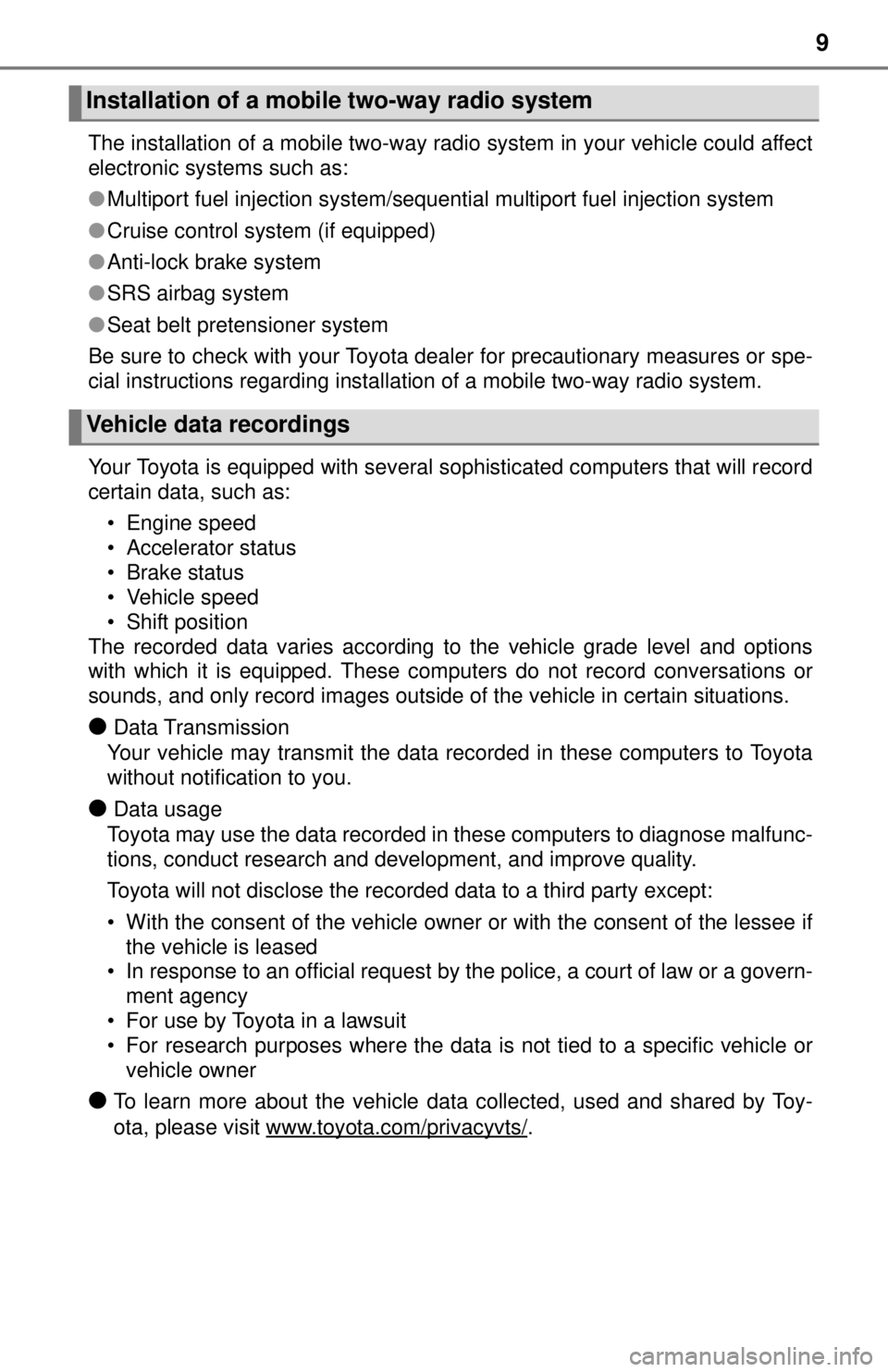
9
The installation of a mobile two-way radio system in your vehicle could affect
electronic systems such as:
●Multiport fuel injection system/sequential multiport fuel injection system
● Cruise control system (if equipped)
● Anti-lock brake system
● SRS airbag system
● Seat belt pretensioner system
Be sure to check with your Toyota dealer for precautionary measures or spe-
cial instructions regarding installation of a mobile two-way radio system.
Your Toyota is equipped with several sophisticated computers that will record
certain data, such as: • Engine speed
• Accelerator status
• Brake status
• Vehicle speed
• Shift position
The recorded data varies according to the vehicle grade level and options
with which it is equipped. These computers do not record conversations or
sounds, and only record images outside of the vehicle in certain situati\
ons.
●Data Transmission
Your vehicle may transmit the data re corded in these computers to Toyota
without notification to you.
●Data usage
Toyota may use the data recorded in these computers to diagnose malfunc-
tions, conduct research and development, and improve quality.
Toyota will not disclose the recorded data to a third party except:
• With the consent of the vehicle owner or with the consent of the lessee if the vehicle is leased
• In response to an official request by the police, a court of law or a govern-
ment agency
• For use by Toyota in a lawsuit
• For research purposes where the data is not tied to a specific vehicle or
vehicle owner
●To learn more about the vehicle data collected, used and shared by Toy-
ota, please visit www.toyota.com/privacyvts/
.
Installation of a mobile two-way radio system
Vehicle data recordings
Page 10 of 640

10
This vehicle is equipped with an event data recorder (EDR). The main pur-
pose of an EDR is to record, in certain crash or near crash-like situations,
such as an air bag deployment or hitting a road obstacle, data that will assist
in understanding how a vehicle’s systems performed. The EDR is designed to
record data related to vehicle dynamics and safety systems for a short period
of time, typically 30 seconds or less.
The EDR in this vehicle is designed to record such data as:• How various systems in your vehicle were operating;
• Whether or not the driver and passenger safety belts were buckled/fas-tened;
• How far (if at all) the driver was depressing the accelerator and/or brake
pedal; and,
• How fast the vehicle was traveling.
These data can help provide a better understanding of the circumstances in
which crashes and injuries occur.
NOTE: EDR data are recorded by your vehicle only if a non-trivial crash situ-
ation occurs; no data are recorded by the EDR under normal driving condi-
tions and no personal data (e.g., name, gender, age, and crash location) are
recorded. However, other parties, such as law enforcement, could combine
the EDR data with the type of personally identifying data routinely acquired
during a crash investigation.
To read data recorded by an EDR, special equipment is required, and access
to the vehicle or the EDR is needed. In addition to the vehicle manufacturer,
other parties, such as law enforcement, that have the special equipment, can
read the information if they have access to the vehicle or the EDR.
●Disclosure of the EDR data
Toyota will not disclose the data recorded in an EDR to a third party except
when:
• An agreement from the vehicle’s owner (or the lessee for a leased vehi- cle) is obtained
• In response to an official request by the police, a court of law or a govern-
ment agency
• For use by Toyota in a lawsuit
However, if necessary, Toyota may:
• Use the data for research on vehicle safety performance
• Disclose the data to a third party for research purposes without disclosing information about the specific vehicle or vehicle owner
Event data recorder